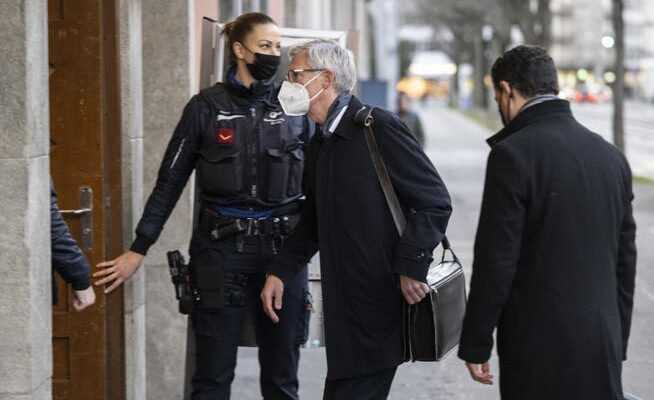Andreas Etter is a key figure in the investment business of the former Raiffeisen boss Pierin Vincenz and his partner Beat Stocker. Etter had a clear and structured appearance in court. Further, Stocker’s defense attorneys presented an alternate version of events.
Investnet co-founder Andreas Etter appears on Wednesday at the Zurich Volkshaus for the Raiffeisen process.
The public prosecutor had set the bar high in the trial of ex-Raiffeisen boss Pierin Vincenz. In her pleading before the Zurich District Court, she described Andreas Etter, one of the co-accused founders of the investment company Investnet, through which Vincenz and the co-defendant Beat Stocker are said to have accrued millions, as a highly talented manager who had fallen away from the good side. As a man who put his “extraordinary skills at the service of bribery”. Etter was absent in the first week of the trial due to a Covid disease. He is accused of aiding and abetting fraud.
On the fifth day of the trial, Andreas Etter made his big appearance. Judge Sebastian Aeppli questioned him after he had greeted those present at 8:15 sharp “in front of today’s clearly thinned out rows” in the large auditorium of the Zurich Volkshaus. Etter was able to score in the following 75 minutes with a high level of detailed knowledge and a great memory.
alternative explanations
Defense attorney Andreas Blattmann later resumed his plea for the accused Beat Stocker, which had been postponed at the end of January. The former head of the credit card company Aduno and Vincenz’s long-standing strategy consultant is the prosecution’s “brain” and mastermind of the entire affair. It is undisputed that he had privately held shares in several companies that were later bought by Aduno and Raiffeisen. In the case of Vincenz, this has so far only been proven beyond doubt in the case of one transaction: the purchase of Commtrain, a provider of credit card terminals, by Aduno.
For Blattmann it was the first big appearance in such a popular case. He countered each allegation made by the prosecution with a detailed alternative explanation of how the emails, chats and processes presented came about. Using an “actual chronology”, he showed individual events in an often much broader context than the prosecution had presented. In addition, Blattmann kept citing statements from former managers at Raiffeisen and Aduno from witness interviews. In several cases he showed that the prosecution could have taken original quotations out of context and that the facts could also be interpreted completely differently. Blattmann went on to say that, contrary to the accusation in the indictment, Stocker had always invested correctly and privately in companies such as Commtrain or Investnet in his role as an entrepreneur, at personal risk. In addition, at the beginning of such an investment, he never only pursued the plan of selling the respective company to Raiffeisen or Aduno. There were always other options, such as the involvement of another company, in the room.
Blattmann’s plea lasted a total of more than eight hours. His approach can be exemplified by the CHF 2.9 million that Stocker transferred from his Julius Baer account to the Vincenz couple’s joint account at Raiffeisenbank Lugano in June 2015. This transaction, which was leaked to the finance portal “Inside Paradeplatz” in spring 2016, triggered the entire Vincenz affair: it was noticeable that a few days earlier, Stocker’s account had received a payment that was around twice as large. At that time, the Investnet founders had paid their covert private third-party shareholder Stocker a first share of the income that came from the gradual takeover of Investnet by Raiffeisen; a total of 5.9 million Swiss francs.
A transaction with consequences
The prosecution argued that the CHF 2.9 million was a bribe paid by Stocker to his accomplice Vincenz, who was also secretly involved. Blattmann countered in court: It was a loan. In the spring of 2015, it became increasingly clear to Vincenz that he needed more liquid funds. After his resignation as head of the bank at Raiffeisen, his wages ceased to exist in October. And with the decision to personally participate in Investnet in the next phase, his financial risk situation would have increased significantly. According to Blattmann, Vincenz knew that he would need millions in liquidity in the future.
Stocker had this liquidity and due to the “friendly relationship” agreed to conclude a loan agreement. However, since he wanted to secure the amount for “future loan requests”, he explained to Vincenz that he was only willing to grant loans up to a maximum of half the amounts that he had received himself. According to Blattmann, this was agreed in the contract.
Blattmann also went into the documented back and forth in the weeks before the transfer. Vincenz kept sending Stocker messages, including a photo with the property he wanted to buy in Ticino. This is intended to support the alternative explanation that the 2.9 million francs went as a loan to buy this house. Time will tell who the court believes.
